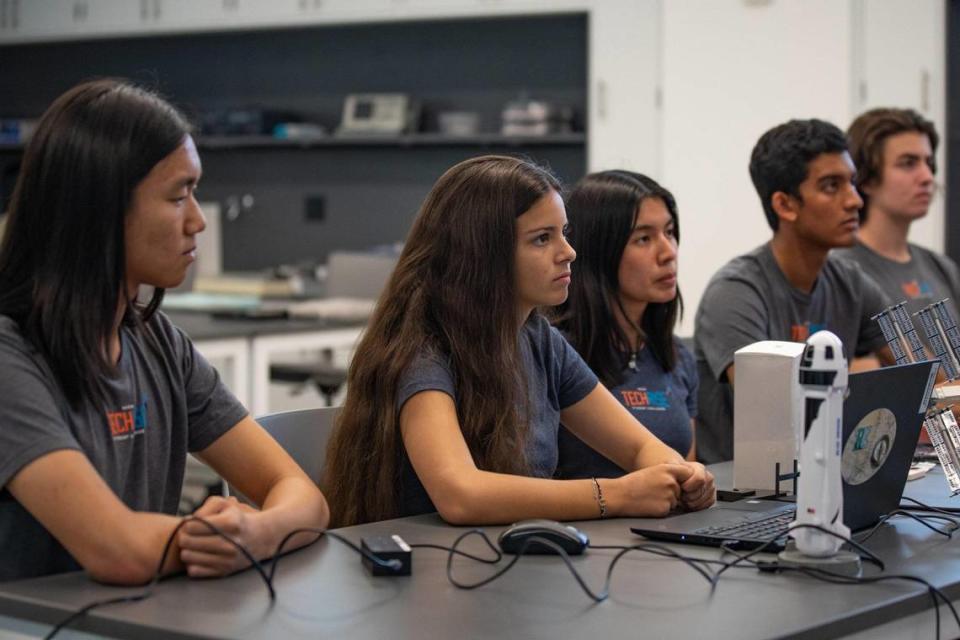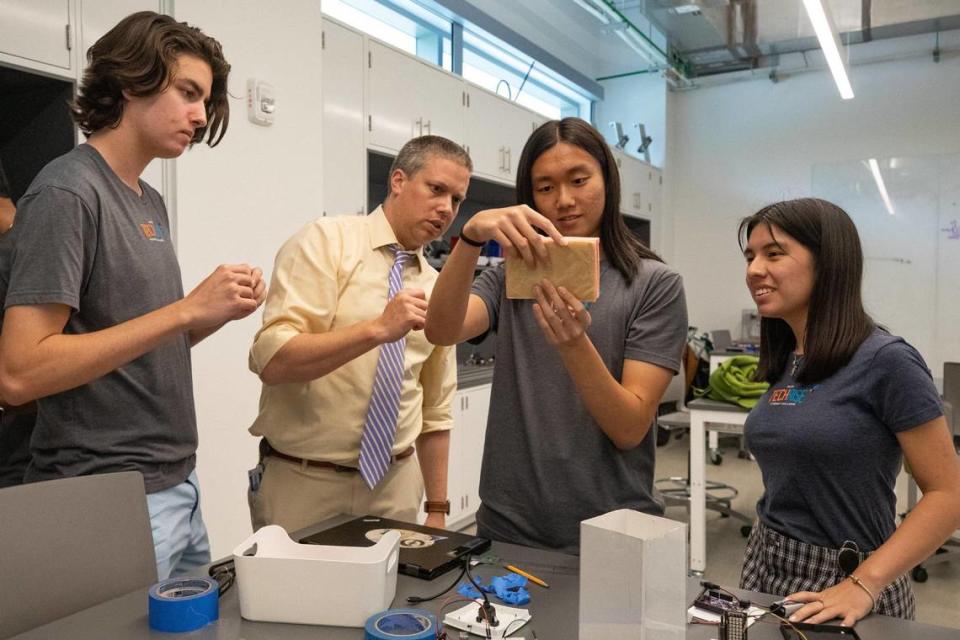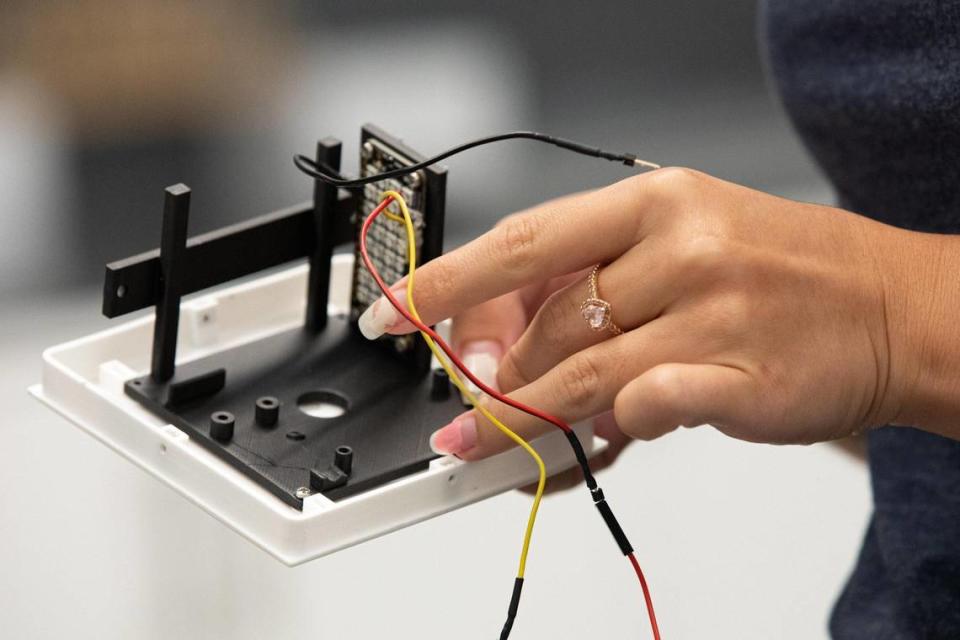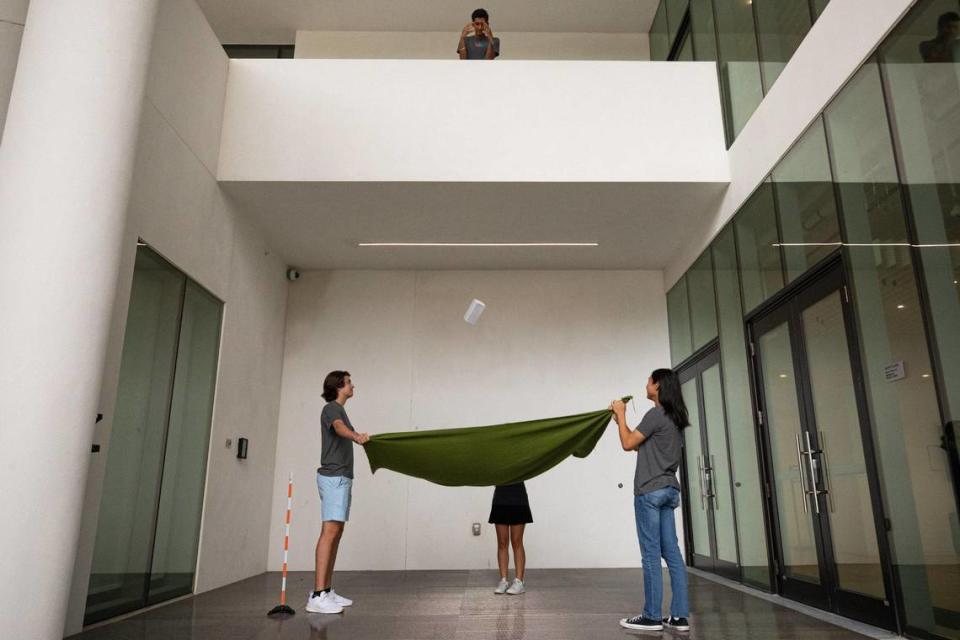A high school science experiment at Ransom Everglades will soon launch into space
A group of students at Ransom Everglades High School in Coconut Grove will see their science experiment launched on a Blue Origins rocket, as part of a program sponsored by NASA.
The milestone is thrilling for the physics students after dealing with a few failures and technological mysteries.
Last year, their physics teacher, Paul Natland, told the students about the competition. So a group got together, called themselves The Zero G’s — and started brainstorming an experiment. They wanted to study capillary action, which is the process of a liquid flowing in a space without the assistance of gravity.
First, they watched a video in which someone uses polyethylene glycol, a “self-pouring liquid,” and a Boyle’s perpetual flask to attempt to create a system of perpetual motion.
A few months later, after working through a few different design ideas, they came up with their own experiment to test perpetual motion. It is a science experiment in a container about the size of a large box of tissues, and involves the use of glass tubes, liquid, and a camera which they programmed themselves.
The Ransom students’ work was accepted by a student challenge called TechRise. The experiment they submitted was one of only 57 accepted out of a pool of 600.
When they found out their application was accepted, senior Arjun Badwal said to another student: “This is crazy! I am so excited!”
The students say they understand how rare it is to be able to send their own experiment into space.
After months of working with NASA scientists, debating the best method for achieving their goals, 3-D printing parts, blowing glass, and programming camera lenses, the students have a design they feel good about sending up into space.
Last week, they tested the design by dropping it off the third floor of the STEM building at Ransom High School, 3575 Main Highway in Miami.
The drop-test simulated what it will be like when the experiment falls in zero gravity, as it will inside Jeff Bezos’ Blue Origin rocket
As part of the program, the students received mentorship from NASA scientists. And for the students, all of whom love space, the first time they spoke on Zoom with a NASA scientist was surreal.
“I was nervous and excited,” said Badwal, who became the group’s unofficial glassmaker during the preparation for the experiment.
But now talking with NASA scientists feels casual to them. Last week, the students had one of their final meetings with NASA TechRise technical advisor Claire Bengtson over a video call.

Overall, she was confident in their design, and just had a few suggestions about epoxying parts together, “beefing up the 3D design,” and potentially adding a second camera to the inside of the experiment, a solution she provided in response to the student’s concern that the data imagery they were receiving was slightly pixelated. The students also suggested adding a grid to the inside of the box to more accurately measure what is going on.
“I think it is important for students to see how the science they are learning is applied,” Bengtson said. “The parameters of a real space flight test are difficult to replicate here on earth. There is really nothing that can substitute for a real suborbital test.”
The students are trying to understand how perpetual motion works by testing the movement of fluids through space. Under normal gravity conditions, the capillary effect is not noticeable. But under zero gravity, the dominating gravity effect is removed, so the students expect the liquid inside the tube will be pulled around. Using the cameras they installed inside the experiment box, they will observe the speed and other characteristics of the liquid.
Essentially, they are trying to figure out how to let liquid travel the longest possible distance.
“If we remove downward force, how many run-throughs will the liquid be able to go through?” asked Sofia Paraoulaki, a student whose dream is to attend MIT.
“In an ideal scenario, we could create energy, which could have real world implications such as helping power water turbines, or allowing scientists to refuel while in space,” Paraoulaki said.
Badwal said he is excited about seeing whether it works during free fall, and “seeing whether it’s a good idea.” When the experiment is in the rocket, it will receive three full minutes of microgravity.
Inside the Blue Origin rocket, there will be slots or what is known as a “feather nano sub orbital halo locker system” for different small-scale science experiments, including that of the five students from Ransom.
Not only are the students excited about launching their experiment into space, but they want to write a paper afterward so that researchers studying perpetual motion and capillary action can learn from their findings.

Initially, the students planned to use a portion of the $1,500 budget from NASA to pay a manufacturer to fabricate the glass tube needed for their experiment. But as students started making the glass on their own, they realized they could do it themselves.
Now, as the students looked at dozens of mock-up versions of the glass they had made, one remarked “this one isn’t the greatest,” a testament to how much more precise their glass-blowing skills had become since the beginning.
And by making the glass themselves, the students have some extra money left over. They plan to use it for a pizza party.
The students were surprised at how happy they were with their final design, which differed so much from their original idea.
“I couldn’t be more proud of us,” Paraoulaki said. “We were definitely scrambling to get it together, but we did it.”

According to the students, around 90% of the design process was troubleshooting.
“I do not know if it will work as intended. But if it does, perpetual motion would solve the energy crisis and facilitate interplanetary research,” Paraoulaki said.
Next week, they will carefully ship out their experiment, in anticipation of the official launch into space scheduled for 2023.


